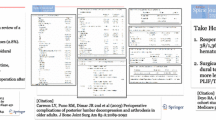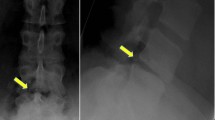Abstract
Purpose
Lateral lumbar interbody fusion (LLIF) is a minimally invasive technique that has gained growing interest in recent years. We performed a retrospective review of the medical records and operative reports of patients undergoing LLIF between March 2006 and December 2009. We seek to identify the incidence and nature of neurological deficits following LLIF.
Methods
New occurring sensory and motor deficits were recorded at 6 and 12 weeks as well as 6- and 12 months of follow-up. Motor deficits were grouped according to the muscle weakness and severity and sensory deficits to the dermatomal zone. New events were correlated to the patient demographics, pre-operative diagnosis, operative levels, and duration of surgery. At each post-operative time-point patients were queried regarding the presence of leg pain.
Results
A total of 235 patients (139 F; 96 M) with a total of 444 levels fused were included. Average age was 61.5 and mean BMI 28.3. At 12 months’ follow-up, the prevalence of sensory deficits was 1.6%, psoas mechanical deficit was 1.6% and lumbar plexus related deficits 2.9%. Although there was no significant correlation between the surgical level L4–5 and an increased psoas mechanical flexion or lumbar plexus related motor deficit, a trend was observed. Independent risk factors for both psoas mechanical hip flexion deficit and lumbar plexus related motor deficit was duration of surgery.
Conclusion
LLIF is a valuable tool for achieving fusion through a minimally invasive approach with little risk to neurovascular structures.





Similar content being viewed by others
References
Oliveira L, Marchi L, Coutinho E, Pimenta L (2010) A radiographic assessment of the ability of the extreme lateral interbody fusion procedure to indirectly decompress the neural elements. Spine (Phila Pa 1976) 35(26 Suppl):S331–S337
Sharma AK, Kepler CK, Girardi FP, Cammisa FP, Huang RC, Sama AA (2011) Lateral lumbar interbody fusion: clinical and radiographic outcomes at 1 year: a preliminary report. J Spinal Disord Tech 24:242–250
Ozgur BM, Aryan HE, Pimenta L et al (2006) Extreme lateral interbody fusion (XLIF): a novel surgical technique for anterior lumbar interbody fusion. Spine J 6:435–443
Berjano P, Lamartina C (2011) Minimally invasive lateral transpsoas approach with advanced neurophysiologic monitoring for lumbar interbody fusion. Eur Spine J 20(9):1584–1586
Moro T, Kikuchi S, Konno S et al (2003) An anatomic study of the lumbar plexus with respect to retroperitoneal endoscopic surgery. Spine 28:423–428
Park DK, Lee MJ, Lin EL et al (2010) The relationship of intrapsoas nerves during a transpsoas approach to the lumbar spine. J Spinal Disord Tech 23:223–228
Benglis DM, Vanni S, Levi AD et al (2009) An anatomical study of the lumbosacral plexus as related to the minimally invasive transpsoas approach to the lumbar spine. J Neurosurg Spine 10:139–144
Regev GJ, Chen L, Dhawan M et al (2009) Morphometric analysis of the ventral nerve roots and retroperitoneal vessels with respect to the minimally invasive lateral approach in normal and deformed spines. Spine (Phila Pa 1976) 34:1330–1335
Kepler CK, Bogner EA, Herzog RJ et al (2010) Anatomy of the psoas muscle and lumbar plexus with respect to the surgical approach for lateral transpsoas interbody fusion. Eur Spine J (Epub ahead of print)
Tormenti MJ, Maserati MB, Bonfield CM, Okonkwo DO, Kanter AS (2010) Complications and radiographic correction in adult scoliosis following combined transpsoas extreme lateral interbody fusion and posterior pedicle screw instrumentation. Neurosurg Focus 28:E7
Rodgers WB, Gerber EJ, Patterson J (2011) Intraoperative and early postoperative complications in extreme lateral interbody fusion: an analysis of 600 cases. Spine (Phila Pa 1976) 36:26–32
Tohmeh AG, Rodgers WB, Peterson MD (2011) Dynamically evoked, discrete-threshold electromyography in the extreme lateral interbody fusion approach. J Neurosurg Spine 14:31–37
Isaacs RE, Hyde J, Goodrich JA, Rodgers WB, Phillips FM (2010) A prospective, nonrandomized, multicenter evaluation of extreme lateral interbody fusion for the treatment of adult degenerative scoliosis: perioperative outcomes and complications. Spine (Phila Pa 1976) 35(26 Suppl):S322–S330
Papanastassiou ID, Eleraky M, Vrionis FD (2011) Contralateral femoral nerve compression: an unrecognized complication after extreme lateral interbody fusion (XLIF). J Clin Neurosci 18:149–151
Pimenta L, Oliveira L, Schaffa T, Coutinho E, Marchi L (2011) Lumbar total disc replacement from an extreme lateral approach: clinical experience with a minimum of 2 years’ follow-up. J Neurosurg Spine 14:38–45
Youssef JA, McAfee PC, Patty CA, Raley E, DeBauche S, Shucosky E, Chotikul L (2010) Minimally invasive surgery: lateral approach interbody fusion: results and review. Spine (Phila Pa 1976) 35(26 Suppl):S302–S311
Uribe JS, Arredondo N, Dakwar E et al (2010) Defining the safe working zones using the minimally invasive lateral retroperitoneal transpsoas approach: an anatomical study. J Neurosurg Spine 13:260–266
Hu WK, He SS, Zhang SC, Liu YB, Li M, Hou TS, Ma XL, Wang J (2011) An MRI study of psoas major and abdominal large vessels with respect to the X/DLIF approach. Eur Spine J 20(4):557–562
Houten JK, Alexandre LC, Nasser R, Wollowick AL (2011) Nerve injury during the transpsoas approach for lumbar fusion. J Neurosurg Spine 27. (Epub ahead of print)
Mura PP, Costaglioli M, Piredda M, Caboni S, Casula S (2011) TLIF for symptomatic disc degeneration: a retrospective study of 100 patients. Eur Spine J 20(Suppl 1):S57–S60
Barnes B, Rodts GE Jr, Haid RW Jr, Subach BR, McLaughlin MR (2002) Allograft implants for posterior lumbar interbody fusion: results comparing cylindrical dowels and impacted wedges. Neurosurgery 51:1191–1198 (discussion 1198)
Villavicencio AT, Burneikiene S, Bulsara KR, Thramann JJ (2006) Perioperative complications in transforaminal lumbar interbody fusion versus anterior-posterior reconstruction for lumbar disc degeneration and instability. J Spinal Disord Tech 19:92–97
Fantini GA, Pappou IP, Girardi FP, Sandhu HS, Cammisa FP Jr (2007) Major vascular injury during anterior lumbar spinal surgery: incidence, risk factors, and management. Spine (Phila Pa 1976) 32:2751–2758
Acknowledgments
The authors would like to express their appreciation to Joe Nguyen for assistance in the statistical evaluation.
Conflict of interest
None.
Author information
Authors and Affiliations
Corresponding author
Rights and permissions
About this article
Cite this article
Pumberger, M., Hughes, A.P., Huang, R.R. et al. Neurologic deficit following lateral lumbar interbody fusion. Eur Spine J 21, 1192–1199 (2012). https://doi.org/10.1007/s00586-011-2087-9
Received:
Revised:
Accepted:
Published:
Issue Date:
DOI: https://doi.org/10.1007/s00586-011-2087-9




